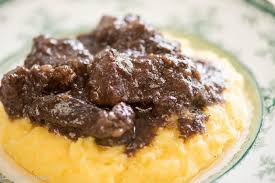Carbonada: Valle d’Aosta’s Hug-in-a-Bowl Alpine Stew
Slow-cooked in red wine and served with polenta, this rich Alpine beef stew tastes like winter comfort straight from Italy’s highest peaks.
FOODVALLE D'AOSTA


Imagine a snowy evening in the Italian Alps, the air crisp and scented with pine, and a bubbling pot on the stove sending waves of rich, winey aroma through the room. Carbonada is not just food—it’s the kind of dish that hugs you from the inside out. Have you ever tasted something that feels like a winter blanket in a bowl? This is it.
History and Origins:
Carbonada is a traditional dish from the Valle d’Aosta region, shaped by centuries of mountain living. In times when preservation was key, locals would slow-cook beef in red wine to make it tender and keep it flavorful for days. It’s believed that the name “carbonada” comes from the old practice of cooking it slowly over the embers (carbone), a method that gave the stew its deep, mellow taste.
Ingredients and Preparation:
The star ingredients are beef (usually chuck or shoulder), plenty of onions, and a robust red wine—often local varieties like Torrette or Fumin. First, the onions are slowly softened until golden and sweet, then the beef is added and browned gently. A generous pour of wine follows, along with bay leaves, cloves, and sometimes a hint of cinnamon. The stew is left to simmer for hours until the meat is meltingly tender and the sauce thick and silky. Traditionally, it’s served with creamy polenta to soak up every drop.
Where to Taste It:
For the most authentic carbonada, head to rustic trattorias in Valle d’Aosta. In Aosta, Trattoria degli Artisti is famous for serving it with a side of steaming polenta and local Fontina cheese. In Cogne, Lou Ressignon offers a refined yet traditional version, perfect after a day of hiking or skiing. If you’re in Courmayeur during winter, stop by La Terrazza, where they pair carbonada with a glass of bold Fumin wine.
For a truly atmospheric experience, try it in a mountain refuge like Rifugio Bertone, where you can eat while overlooking snow-dusted peaks. And if you visit in late January, the Fiera di Sant’Orso in Aosta often features carbonada at food stalls, served hot to warm festival-goers.
Conclusion:
One spoonful of carbonada and you’ll understand why it’s more than just a recipe—it’s a warm Alpine memory you can taste. Whether by a fireplace in a high-altitude refuge or at a bustling winter fair, it’s a bite of Valle d’Aosta’s soul.
